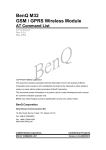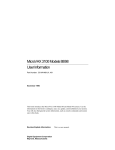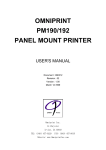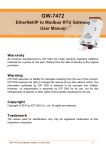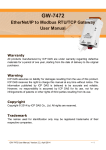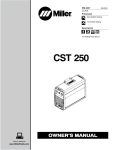Download Application Note Construction of SMS PDU`s
Transcript
Application Note Construction of SMS PDU’s First edition (June 2003) Sony Ericsson Mobile Communications. publishes this manual without making any warranty as to the content contained herein. Further Sony Ericsson Mobile Communications. reserves the right to make modifications, additions and deletions to this manual due to typographical errors, inaccurate information, or improvements to programs and/or equipment at any time and without notice. Such changes will, nevertheless be incorporated into new editions of this manual. All rights reserved. © Sony Ericsson Mobile Communications., 2003 Construction of SMS PDU’s Contents 1 INTRODUCTION.................................................................................................................... 4 2 ABOUT SMS.......................................................................................................................... 5 3 WHAT IS A PDU?.................................................................................................................. 5 3.1 3.2 4 TRANSMISSION ORDER ...................................................................................................... 6 REPRESENTATIONS ........................................................................................................... 7 SMS-SUBMIT ........................................................................................................................ 8 4.1 THE SERVICE CENTER ADDRESS (SCA)............................................................................. 8 4.2 THE NEXT OCTET (TP-MTI AND FRIENDS) ......................................................................... 11 4.2.1 Message Type indicator (TP-MTI) ......................................................................... 11 4.2.2 Reject Duplicates (TP-RD) .................................................................................... 12 4.2.3 Validity Period Format (TP-VPF) ........................................................................... 12 4.2.4 Status Report Request (TP-SRR) ......................................................................... 12 4.2.5 User Data header Indicator (TP-UDHI) ................................................................. 13 4.2.6 Reply Path (TP-RP) ............................................................................................... 13 4.2.7 Back to our example – what does it mean? .......................................................... 13 4.3 MESSAGE REFERENCE FIELD (TP-MR)............................................................................. 14 4.4 DESTINATION ADDRESS (TP-DA)....................................................................................... 14 4.5 PROTOCOL IDENTIFIER (TP-PID) ..................................................................................... 15 4.6 DATA CODING SCHEME (TP-DCS).................................................................................... 16 4.7 VALIDITY PERIOD (TP-VP) ............................................................................................... 19 4.8 USER DATA LENGTH (TP-UDL) ........................................................................................ 20 4.9 USER DATA (TP-UD) ...................................................................................................... 20 5 SMS-DELIVER..................................................................................................................... 25 5.1 SERVICE CENTRE ADDRESS ............................................................................................. 25 5.2 TP-MTI AND MORE FRIENDS ............................................................................................ 25 5.2.1 Message Type indicator (TP-MTI) ......................................................................... 26 5.2.2 More Messages to Send (TP-MMS) ...................................................................... 26 5.2.3 Status Report Indication (TP-SRI) ......................................................................... 26 5.2.4 User Data header Indicator (TP-UDHI) ................................................................. 26 5.2.5 Reply Path (TP-RP) ............................................................................................... 27 5.2.6 Back to our example .............................................................................................. 27 5.3 THE ORIGINATING ADDRESS (TP-OA)............................................................................. 27 5.4 PROTOCOL IDENTIFIER (TP-PID) ..................................................................................... 28 5.5 DATA CODING SCHEME (TP-DCS).................................................................................... 28 5.6 THE SERVICE CENTRE TIME STAMP (TP-SCTS) ................................................................ 28 5.7 USER DATA LENGTH (TP-UDL) ....................................................................................... 29 5.8 USER DATA (TP-UD) ................................................................................................... 29 LZT 123 7632 R1A 3 Construction of SMS PDU’s 1 Introduction This document is to help an integrator in getting started with sending SMS messages in the PDU format. Enough information is given here for anyone to begin constructing the most basic PDU’s and send them, using AT commands, from one GSM module/mobile to another. LZT 123 7632 R1A 4 Construction of SMS PDU’s 2 About SMS SMS, as you already probably know stands for Short Message Service. SMS provides a means of sending messages of limited size from and to GSM mobile stations. SMS makes use of something called a Service Centre, which acts as a store and forward centre for the SMS messages. Two different types of SMS services can be defined: Mobile Originated (MO) – Mobile originated SMS will be transported from a mobile station to the Service Centre. These may be destined for other mobiles or may even be destined for other services which the GSM network and Service Centre supports. Mobile Terminated (MT) – Mobile terminated SMS will be transported from a Service Centre to a mobile Station. MO SMS (SMS-SUBMIT PDU) SMSSERVICE CENTER MT SMS (SMS-DELIVER PDU) Mobile Station Mobile Station 3 What is a PDU? PDU is short for Protocol Data Unit (or it could even be Packet Data Unit, the different meanings are in use). These data units represent how the digital information is coded and structured when it sent over the air interface. When we use a mobile phone, we usually enter a text message by the keypad of the phone, give it a phone number to be sent to, press the “YES” button and, usually, receive a “MESSAGE SENT” notification from the phone. With a GSM module this process has to be performed with AT commands from a terminal of some kind, since there is no keyboard. In some cases the module does not support text mode SMS, and the message must be coded as a PDU. Using the PDU mode gives the user much more power over the information to be sent and how it is sent. For instance one may not wish to send a text message, but may wish to send raw Data. PDU format will allow you to do this. There are different kinds of PDU involved in SMS messaging, from SMSREPORT, SMS-COMMAND etc. etc. but we will consider only two different types here, probably the most important as well. Related to Mobile originated SMS is the PDU of type SMS-SUBMIT. This is a PDU that is sent from one Mobile terminal to the Service centre. LZT 123 7632 R1A 5 Construction of SMS PDU’s Related to Mobile terminated SMS, an SMS that is received by a Mobile from the Service centre is SMS-DELIVER PDU. What does a PDU look like? Well, just to complicate things a PDU is a Service Centre Address (SCA), followed by a Transport Protocol Data Unit. PDU = SCA + TPDU An SMS-SUBMIT PDU looks something like this: 07916407058099F911000A8170607896200000A71554747A0E4ACF416 110945805B5CBF379F85C06 The SCA is shown in bold. The rest is the TPDU. The PDU format is a hexadecimal encoded binary format, which means that 2 hexadecimal digits represent a byte of data. When one refers to Data being transmitted, a byte is usually called an octet (bytes are stored, and octets are transmitted). The TPDU consists of a header containing control information, and a “payload” containing the User Data. We will examine the different parts in detail later. Some Modules and mobiles do not support the PDU format but only the TPDU format. In that case it’s just a simple matter to remove the SCA and work with TPDU only. You may ask the question: If a SMS must be sent via a Service Centre doesn’t the SMS have to include the SCA? The answer here is that the SCA is stored on the SIM card and is taken from there. It can be changed via the use of AT commands. The good thing about the PDU format is that by changing the SCA in the PDU the SMS can be sent via any Service centre of your choice (as long as your network operator allows it). If one wishes to use the default SCA (from the SIM card) in the PDU, the SCA part of the PDU can be replaced with 00. The PDU would look like this: 0011000A8170607896200000A71554747A0E4ACF416110945805B5CBF 379F85C06 Before we take a look at the meaning of all this hexadecimal and what it means, we need to consider a few other things first. 3.1 Transmission order Octets in a PDU are transmitted according to their order. Octets at the beginning of the PDU are transmitted first. This is the same for the individual bits of the octets. Thus the low order bits are transmitted first. Here is an example of octet transmission. Say for example we wanted to send the following octets from one mobile to another (if it were possible): 03FFFFE0 LZT 123 7632 R1A 6 Construction of SMS PDU’s We could write a table a table using the binary representation: OCTET BINARY REPRESENTATION 7 6 5 4 3 2 1 0 03 0 0 0 0 0 0 1 1 FF 1 1 1 1 1 1 1 1 FF 1 1 1 1 1 1 1 1 E0 1 1 1 0 0 0 0 0 The transmission order would be as follows (the first bit sent being the rightmost): 11100000111111111111111100000011→ 3.2 Representations There are a few different meanings given to the hexadecimal representations. The information in a PDU takes the form of pure hexadecimal integers, decimal digits, and alphanumeric information (although still represented as hexadecimal). For instance some fields in the PDU are squeezed into one octet, and will be seen as a hexadecimal number. One octet is two hexadecimal digits. Sometimes the information can clearly seen to be decimal digits. For a decimal digit only a half octet (4-bits) is required. Alphanumeric representation is based on the default alphabet defined later on and in GSM 03.38. This mainly applies to the User Data. All this should come naturally as we follow the examples in the text. LZT 123 7632 R1A 7 Construction of SMS PDU’s 4 SMS-Submit Recall that an SMS-SUBIT type PDU is what we want to send to another mobile. It is what we “submit” to the service centre to be delivered to the chosen destination. To understand the various field of a TPDU of type SMS-SUBMIT it is best to begin with an example and then break the TPDU down into its various fields. Also we will consider the whole PDU (PDU = SCA + TPDU) when discussing SMS-SUBMIT and SMS-DELIVER type TPDU’s. We can begin with the example from the earlier sections: 07916407058099F911000A8170607896200000A71554747A0E4ACF416 110945805B5CBF379F85C06 We can start by breaking it down into the various fields: 4.1 The Service Center Address (SCA) 07916407058099F911000A8170607896200000A71554747A0E4ACF416 110945805B5CBF379F85C06 This is the Service Centre Address (SCA). It has its own special address field. We can break it down as follows: OCTET 07 BINARY REPRESENTATION FIELD MEANING 7 6 5 4 3 2 1 0 0 0 0 0 0 1 1 1 ADDRESS LENGTH: This octet declares the number of octets to follow. 91 1 0 0 1 0 0 0 1 This is the Type of Address field. There are two different fields in this octet. Bits 0-3 are the Numbering plan Identification. Bits 4-6 are the Type of Number. Bit 7 is a fill bit. See below for more details. 64 0 1 1 0 0 1 0 0 The digits 4 and 6 07 0 0 0 0 0 1 1 1 The digits 7 and 0 05 0 0 0 0 0 1 0 1 The digits 5 and 0 80 1 0 0 0 0 0 0 0 The digits 0 and 8 LZT 123 7632 R1A 8 Construction of SMS PDU’s 99 1 F9 0 1 1 0 1 1 1 1 0 1 0 0 0 1 The digits 9 and 9 1 The digit 9. Since there are an odd number of digits in this SCA then the bits 4-7 in this octet are fill bits. We can look in more detail at the Type of Address Octet: 7 6 1 5 Type-of-number 4 3 2 1 0 Numbering-plan-identification The values for the two fields, Type of number and numbering plan identification can be chosen according to the table below: BIT NUMBER BIT VALUE EXPLANATION 7 1 ALWAYS Fill bit Type of number: 6,5,4 000 Unknown 001 International number 010 National number 011 Network specific number 100 Subscriber number 101 Alphanumeric, (coded according GSM TS 03.38 7-bit default alphabet) 110 Abbreviated number 111 Reserved for extension 3,2,1,0 LZT 123 7632 R1A to Numbering-plan-identification: 0000 Unknown 0001 ISDN/telephone numbering plan 0011 Data numbering plan (X.121) 0100 Telex numbering plan 1000 National numbering plan 9 Construction of SMS PDU’s 1001 Private numbering plan 1010 ERMES numbering plan 1111 Reserved for extension All other values are reserved. Now going back to our example we have enough information to understand the SCA address: 07916407058099F9 First we know that after the first octet, there are 7 octets to follow in the SCA address field. Secondly looking closely at our example we see that the octet for the type of address is 91. According to the table above, this means that we have an International number and that it uses the ISDN/telephone numbering plan. And thirdly, looking at the rest of the SCA, we see that indeed we have an international number: 46 705008999 (46 being the dialing code for Sweden) Looking closely at the SCA number and remembering the transmission order of the octet bits, we see that quite simply each pair of digits in the number are reversed. This means that it is quite simple to convert from a telephone number to the PDU format: 1) Write down the number (international or national format it doesn’t matter). 46705008999 2) If the number has an odd number of digits then add an F at the end. This means that the number will need fill bits (represented by the hexadecimal F) in the last octet. 46705008999F 3) Pair the numbers. 46 70 50 08 99 9F 4) Reverse the digits 64 07 05 08 99 F9 LZT 123 7632 R1A Easy!! 10 Construction of SMS PDU’s As we have talked about before in the earlier sections, it is possible to use the default SCA stored on a SIM card. The SCA is just replaced with a 00, which means that the SCA is of zero length. The mobile or module should be intelligent enough then to find the SCA on the SIM. 4.2 The next octet (TP-MTI and friends) The next octet after the SCA address contains no more than 6 fields. Looking again at the example, we see the octet in question: 07916407058099F911000A8170607896200000A71554747A0E4ACF416 110945805B5CBF379F85C06 These fields are as follows: Reply Path (TPRP) User data header indicator (TPUDHI) Status report request (TP-SRR) 4 3 2 1 0 Message type indicator (TP-MTI) 5 Reject duplicates (TP-RD) 6 Validity Period format (TP-VPF) 7 Here follows a description of each of the fields: 4.2.1 Message Type indicator (TP-MTI) This 2-bit field denotes which type of SMS is represented by the PDU according to the table below. Notice the meaning depends on which “direction” the message is going, from the Service Centre to the Mobile, or from the Mobile to the Service Centre. Message type Bit 1 Bit 0 0 0 SMS-DELIVER SMS-DELIVER REPORT 1 0 SMS-STATUS REPORT SMS-COMMAND 0 1 SMS-SUBMIT REPORT SMS-SUBMIT 1 1 RESERVED LZT 123 7632 R1A Direction SC→MS Direction MS→SC 11 Construction of SMS PDU’s In this document we are only going to consider SMS-SUBMIT and SMSDELIVER PDU’s. 4.2.2 Reject Duplicates (TP-RD) This 1-bit flag located in Bit 2 of the octet in question. This field indicates whether or not the Service Centre shall accept an “identical” SMS from the same originating Mobile when the original SMS is still held at the Service Centre. The comparison is made using the TP-MR, and TP-DA fields only. These fields are explained later. Usually this parameter can be left as 0, which means that duplicates should be accepted by the Service Centre. 4.2.3 Validity Period Format (TP-VPF) This is 2-bit field, and describes the format used for a parameter that comes later in the PDU, namely the validity period (TP-VP). The validity period basically informs the Service Centre how long it should hold a SMS when the destination is unreachable, before discarding the SMS. There are 4 different choices for the validity period, which can be chosen according to the following table: BIT 4 BIT 3 MEANING 0 0 No Validity Period field will be present. 1 0 Relative format used for the Validity Period. 0 1 Enhanced format used for the Validity Period. 1 1 Absolute format used for the Validity period. As will be seen it is usually enough to use the relative format, and it will also be the only format in which we go into any detail in this document. 4.2.4 Status Report Request (TP-SRR) This is another 1-bit flag found in bit number 5 of the octet in question, which basically requests another type of SMS to be returned to the Mobile after the SMS-SUBMIT is sent to the Service Centre. There exists an SMS of type SMS-STATUS REPORT where the status of previously sent SMS’s can be reported. Not all mobile stations, or for that matter, all networks support this type of SMS. Simply put, if it’s a 1, a status report is requested, and 0 otherwise. Normally this parameter can be set to 0. LZT 123 7632 R1A 12 Construction of SMS PDU’s 4.2.5 User Data header Indicator (TP-UDHI) Again this is another 1-bit field found in bit 6 of the octet in question. This parameter describes what the User Data field, TP-UD, (explained further down) will contain. If the value is 1 then the User Data field will contain a User Data Header in addition to the short message, otherwise just the short message. Most mobiles do not support the User Data Header format, which is intended for future use with compressed SMS messages, SIM toolkit messages, and Concatenated SMS messages. Normally the value of this parameter will be 0, and in this document we will not go into any further detail concerning the User Data Header. For those who are interested, we recommend you read the GSM specification GSM 03.40 for the full details of how the User Data header can be used. 4.2.6 Reply Path (TP-RP) The reply path field is a 1-bit field in bit 7 of the octet in question. This parameter says if a reply is requested from the receiving mobile station. If a reply path is requested, the replying mobile station will try to use the same Service Centre that the sending mobile use to ensure a better chance of delivery of the reply. Also the recipient of the SMS may not have SMS available on their subscription. Setting the reply path gives them the opportunity to answer any SMS. Whichever party pays for the reply may depend on the operator. If this parameter is set to 1 then the reply path is set, otherwise, 0. 4.2.7 Back to our example – what does it mean? OK! Now we’re in a position to look at our example again and find out what it means. Remember the value in our PDU? 11: (TP-RP) (TPUDHI) (TPSRR) 0 0 0 LZT 123 7632 R1A 4 3 1 0 2 1 0 0 (TPMTI) 5 (TP-RD) 6 (TPVPF) 7 0 1 13 Construction of SMS PDU’s So we see that TP-MTI is set to 01 and we are sending an SMS from the mobile to the Service Centre, and therefore it says that this is a PDU of type SMS-SUBMIT (as if we needed telling). TP-RD is 0, so we don’t want the Service Centre to reject any duplicates that we may send. TP-VPF is 10 and, therefore, our PDU will be using the relative Validity Period field format. TP-SRR is 0 therefore no Status Report is requested. TP-UDHI is 0 and so there will be no user data header within our User Data. Finally there will be no Reply Path set since we set TP-RP to 0. Could it be simpler? 4.3 Message reference field (TP-MR) Now back to our example, and the next octet 07916407058099F911000A8170607896200000A71554747A0E4ACF416 110945805B5CBF379F85C06 This is the Message reference field, TP-MR). This field is 1 octet in length, and is just a hexadecimal representation of an integer reference number given to the SMS-SUBMIT. The number can range from 0-255 in value. The user can set it to any value, although usually it can be set to 00. It could be used by the user to keep track of and, distinguish between sent, delivered, and received SMS. We see that in our example we have chosen to set this to 00. 4.4 Destination Address (tp-da) The destination address is shown in our example below: 07916407058099F911000A8170607896200000A71554747A0E4ACF416 110945805B5CBF379F85C06 This field represents the mobile number for whom which the SMS is intended. This looks familiar right? Well, it is almost identical to the address field described earlier for the Service Centre. There is only one difference, and that is in the first octet. Remember in the Service Centre Address it was the number of octets to follow in the address field? Now it is the number of digits in the destination mobile subscriber number. LZT 123 7632 R1A 14 Construction of SMS PDU’s The rest is identical to the Service Centre Address as we discussed above. Lets break down the destination address we have in our example: 0A817060789620 OCTET 0A BINARY REPRESENTATION 7 0 6 0 5 0 4 0 3 1 2 1 1 0 FIELD MEANING 0 1 ADDRESS LENGTH: This is the number of digits in the Destination mobile subscriber number. 81 1 0 0 0 0 0 0 1 This is the Type of Address field. There are two different fields in this octet. Bits 0-3 are the Numbering plan Identification. Bits 4-6 are the Type of Number. Bit 7 is a fill bit. 70 0 1 1 1 0 0 0 0 The digits 0 and 7 60 0 1 1 0 0 0 0 0 The digits 0 and 6 78 0 1 1 1 1 0 0 0 The digits 8 and 7 96 1 0 0 1 0 1 1 0 The digits 6 and 9 20 0 0 1 0 0 0 0 0 The digits 0 and 2. The Address length says that the mobile number will consist of 10 digits. The Type of Address field is 81. This means that the Type of Number is National, and the Numbering plan is ISDN/telephone numbering plan (you can check yourself from the earlier tables). And reconstructing the mobile number: 70 60 78 96 20 We see that the Mobile number is: 070-6876902 This is a national number as we expected. Notice that since the number has an even number of digits no fill bits are required! 4.5 Protocol identifier (TP-PID) In our example the Protocol Identifier is shown below: LZT 123 7632 R1A 15 Construction of SMS PDU’s 07916407058099F911000A8170607896200000A71554747A0E4ACF416 110945805B5CBF379F85C06 The use of this octet is very interesting. It provides some useful functionality for SMS. The octet describes the higher-level protocols or interworking devices, which the SMS is intended for, or has arrived from. What does this mean in English? The Service Centre of your network operator may support certain services, for instance it may be capable of converting your SMS to Email, Paging messages, Telex, Teletex, SIM Tool kit information, or visa versa, it all depends on what's connected (interworked) to the Service Centre. This TP-PID field declares to the Service Centre the service for which the SMS is intended, or even which service the PDU has come from. For our purposes, since we are sending information between mobile stations only, we can assume that this Octet is set to 00. For more information on the fields full properties and how to use it we refer you to GSM specification GSM 03.40. It may even be appropriate to contact your network operator for more information on the services available. 4.6 Data coding scheme (TP-DCS) The Data Coding Scheme is given in the following octet of the SMSSUBMIT: 07916407058099F911000A8170607896200000A71554747A0E4ACF416 110945805B5CBF379F85C06 The Data Coding Scheme describes how the User Data (TP-UD) is coded, which type of alphabet/character set is used, and what CLASS the SMS is. We will look at TP-UD later, but for now lets look at the table of how to set the Data Coding Scheme octet and what it means: Coding Group Bits 7-4 Use of bits 3 - 0 General Data Coding indication. Bits 5-0 indicate the following: 00xx Bit 5 = 0, indicates the text is uncompressed Bit 5 =1, indicates the text is compressed using the GSM standard compression algorithm (see GSM 03.42). Bit 4 = 0, indicates that bits 1 to 0 are reserved and have no message class meaning Bit 4 = 1, indicates that bits 1 to 0 have a message class meaning: Bit 1 LZT 123 7632 R1A Bit 0 Message Class 16 Construction of SMS PDU’s 0 0 1 1 0 1 0 1 Class 0 Class 1 Default meaning: ME-specific. Class 2 SIM specific message Class 3 Default meaning: TE specific (see GSM 07.05) Bits 3 and 2 indicate the alphabet being used, as follows: Bit 3 Bit2 Alphabet: 0 0 Default alphabet 0 1 8 bit data 1 0 UCS2 (16bit) 1 1 Reserved NOTE: The special case of bits 7-0 being 0000 0000 indicates the Default GSM Alphabet. Values 0100 through to 1011 Reserved coding groups. Message Waiting Indication Group: Discard Message 1100 Bits 3-0 are coded exactly the same as Group 1101, however with bits 7-4 set to 1100 the mobile may discard the contents of the message, and only present the indication to the user. Message Waiting Indication Group: Store Message This Group allows an indication to be provided to the user about the status of types of message waiting on systems connected to the GSM PLMN. The mobile may present this indication as an icon on the screen, or other MMI indication. The mobile may take note of the Origination Address for messages in this group and group 1100. For each indication supported, the mobile may provide storage for the Origination Address, which is to control the mobile indicator. Text included in the user data is coded in the Default Alphabet. Where a message is received with bits 7-4 set to 1101, the mobile shall store the text of the SMS message in addition to setting the indication. Bits 3 indicates Indication Sense: 1101 Bit 3 0 1 Set Indication Inactive Set Indication Active Bit 2 is reserved, and set to 0 Bit 1 0 0 1 1 Bit 0 0 1 0 1 Indication Type: Voicemail Message Waiting Fax Message Waiting E-Mail Message Waiting Other Message Waiting* * Mobile manufacturers may implement the “Other Message Waiting” indication as an additional indication without specifying the meaning. The meaning of this indication is intended to be standardized in the future, so Operators should not make use of this indication until the standard for this indication is finalized. Message Waiting Indication Group: Store Message 1110 LZT 123 7632 R1A The coding of bits 3-0 and functionality of this feature are the same as for the Message Waiting Indication Group above, (bits 7-4 set to 1101) with the exception that the text included in the user data is coded in the uncompressed 17 Construction of SMS PDU’s UCS2 alphabet. Data coding/message class Bit 3 is reserved and set to 0. 1111 Bit 2 0 1 Message coding: Default alphabet 8-bit data Bit 1 0 0 1 1 Bit 0 0 1 0 1 Message Class: Class 0 Class 1 ME-specific. Class 2 SIM-specific Class 3 TE specific (see GSM 07.05) Lets look at some of the properties of the table above. Default GSM alphabet indicates that the User Data is coded using a 7-bit alphabet, which we will discuss, later in the coming sections. Using the 7bit alphabet up to 160 characters can be sent in an SMS. Other alphabets can be used as well, for instance any 8-bit alphabet, which is agreed upon by the sender and receiver. It is also possible to send 16-bit Unicode (UCS2). What about SMS classes? There exists 4 different types of SMS classes and Classless SMS. These classes can be simply described as follows: Classless SMS This is usually the type sent by a mobile telephone. They are stored in the available memory, usually in the telephone Class 0 SMS These are not stored anywhere, but are sent directly to the telephone display. In a module, since there is no display one can forward the messages to the TE by means of the AT command setting AT+CNMI=3,2. Class 1 SMS These are directed specifically to the mobile equipment if there is memory storage available, otherwise it will be stored in SIM. Class 2 SMS These are directed specifically to SIM. Class 3 SMS These messages shall normally be transferred to the terminal equipment or application, if requested to do so. This is controlled by the AT command AT+CNMI (see the relevant AT command description for more info about this AT command). LZT 123 7632 R1A 18 Construction of SMS PDU’s For a deeper explanation and more information regarding the different SMS classes and their use see the GSM specification 03.38. In our example we see that we have chosen the value 00, which implies a classless SMS. According to the table above this means that our Data will use the default GSM alphabet and is intended for mobile-to-mobile communication. Some other values we could have chosen, and which you may wish to experiment with, could have been: TP-DCS = F0-F3 will give SMS classes 0 to 3 respectively. TP-DCS = F4-F7 will give the 8-bit data versions of the SMS above. In sending 8-bit data from a module to a normal mobile telephone, something interesting can be observed. The received message will be completely garbled. This is because usually a mobile phone understands only the GSM alphabet and will translate an 8-bit alphabet thus. Try it and see! 4.7 Validity period (TP-VP) The Validity Period is the amount of time the Service Center will hold our submitted SMS if the destination address is unreachable. After this time period if the Service Center has still been unable to deliver the SMS to the destination mobile, then the message will be thrown away…lost for ever! As we spoke about before, the field TP-VPF decides the format of the Validity Period field. We will just consider one form of the Validity Period, the relative format. In our example the Validity period is given by the octet shown in bold: 07916407058099F911000A8170607896200000A71554747A0E4ACF416 110945805B5CBF379F85C06 The validity period can be calculated according to the following table: TP-VP VALUE (HEX) TP-VP VALUE (DEC) VALIDITY PERIOD VALUE CALCULATION 00-8F 0-143 (TP-VP+1) x 5mins (i.e. 5min intervals up to 12hrs) 90-A7 144-167 12hrs+((TP-VP-143) x 30mins) A8-C4 168-196 (TPVP-166) x 1day LZT 123 7632 R1A 19 Construction of SMS PDU’s C5-FF 197-255 (TP-VP-192) x 1week The value in our TP-VP field is A7. Using the table above we can calculate the Validity Period. A7hex = 167decimal From the table the formula to use is 12hrs+((TP-VP-143) x 30mins). 12hrs+ ((167-143) x 30 mins) = 12hrs+ (24 x 30mins) = 12hrs + 12hrs =24 hrs Therefore, we have a validity period of one day. As we have said before, there are two other formats for the Validity Period: Absolute and enhanced format. If you are interested in these formats then please refer to GSM specification GSM 03.40. 4.8 User data length (TP-UDL) This field describes how much User Data there is to follow. It is done in two ways. 1) If the User Data is the default GSM alphabet (settings in TP-DCS will tell how the User Data is represented) then the TP-UDL describes the number of characters (or number of septets) in the User Data field. 2) If the User Data is 8-bit data (or octet represented), then the TP-UDL describes the number of octets in the User Data field. In our example the User Data length is given in bold face: 07916407058099F911000A8170607896200000A71554747A0E4ACF416 110945805B5CBF379F85C06 Since we have already declared in TP-DCS that we will send a classless SMS and this implies the default GSM alphabet, then the length we give here is, in fact, the number of characters in our message. 15hex= 21dec, the message we will send as we shall see in the next Section is the phrase: “This is a PDU message”, which is indeed 21 characters. 4.9 User Data (TP-UD) Now we get to the interesting bit. Here is the field for the user data. The user data can be up to 140 octets. We see in our example that we are sending a message of 19 octets. 07916407058099F911000A8170607896200000A71554747A0E4ACF416 110945805B5CBF379F85C06 LZT 123 7632 R1A 20 Construction of SMS PDU’s And as we have already pointed out our data represents characters of the Default GSM alphabet. From the previous section we also saw that we are sending 21 characters. How can we squeeze 21 characters into those 19 octets? The answer is that we are using the default 7-bit GSM alphabet. This means that in those 140 octets we could squeeze 160 characters in total. So when we look at the user data, unfortunately we cannot directly replace each octet with a character, instead we have to break the message down to the bit level and then translate over to the GSM character set. First lets take a look at the character table for the default GSM alphabet: Bit Values B6 0 0 0 0 1 1 1 1 B5 0 0 1 1 0 0 1 1 B4 0 1 0 1 0 1 0 1 0 1 2 3 4 5 6 7 B3 B2 B1 B0 0 0 0 0 0 @ ∆ SP 0 ¡ P ¿ p 0 0 0 1 1 £ _ ! 1 A Q a q 0 0 1 0 2 $ Φ " 2 B R b r 0 0 1 1 3 ¥ Γ # 3 C S c s 0 1 0 0 4 è Λ ¤ 4 D T d t 0 1 0 1 5 é Ω % 5 E U e u 0 1 1 0 6 ù Π & 6 F V f v 0 1 1 1 7 ì Ψ ' 7 G W g w 1 0 0 0 8 ò Σ ( 8 H X h x 1 0 0 1 9 Ç Θ ) 9 I Y i y 1 0 1 0 A LF Ξ * : J Z j z 1 0 1 1 B Ø 1) + ; K Ä k ä 1 1 0 0 C ø Æ , < L Ö l ö 1 1 0 1 D CR æ - = M Ñ m ñ 1 1 1 0 E Å ß . > N Ü n ü 1 1 1 1 F å É / ? O § o à LZT 123 7632 R1A 21 Construction of SMS PDU’s To read from the table is easy. Lets say that we wanted the value for the character “A” then remembering that it is a 7-bit alphabet (no bit number 7 or bit number 7 is set to zero always), bits 6-4 =100 and bits 3-0 =0001. Therefore, we have value 01000001=41hex. Notice at position 1B we have a 1) symbol. This is not a character but a reference to an extension table, which we will not use here but can be found in GSM 03.38 along with other details on the GSM character table. We now need to look at how we pack our User Data into octets when we use the 7-bit alphabet. Lets try to construct some user data by translating the word “TEST” to the hexadecimal representation. Each letter shall be represented by 7 bits. We can denote the individual bits as follows: T6, T5…T0 E6, E5… E0. And so on. The bits are packed as follows: BIT NUMBERS 7 6 5 4 3 2 1 0 E0 T6 T5 T4 T3 T2 T1 T0 S1 S0 E6 E5 E4 E3 E2 E1 T2 T1 T0 S6 S5 S4 S3 S2 0 0 0 0 T6 T5 T4 T3 Notice that we fill with zero’s in the last octet! We can now use the table above, fill in the real values and construct the hexadecimal representation of the word test using the default GSM alphabet. Hex value BIT NUMBERS 7 6 5 4 3 2 1 0 1 1 0 1 0 1 0 0 D4 1 1 1 0 0 0 1 0 E2 1 0 0 1 0 1 0 0 94 0 0 0 0 1 0 1 0 0A So “TEST” would be D4E2940A. Notice two things: LZT 123 7632 R1A 22 Construction of SMS PDU’s 1) The order of transmission as described earlier. 2) The character “T” from the GSM table is given as 54hex. This is not the same as we see above (D4hex). One cannot directly translate. However if one was sending 8-bit data, and interpreting it as an 8-bit alphabet then a direct translation would be possible. The only drawback would be that only 140 characters (octets) could be sent. Let us now try to deconstruct our example User Data. To do this we would have to perform the above procedure backwards. The Data is: 54747A0E4ACF416110945805B5CBF379F85C06 Now this is a long example so we won’t do all of it just a first few characters so you get the idea (in fact, the first 7 octets and then we should get 8 characters right?): Hex value BIT NUMBERS 7 6 5 4 3 2 1 0 54 0 1 0 1 0 1 0 0 74 0 1 1 1 0 1 0 0 7A 0 1 1 1 1 0 1 0 0E 0 0 0 0 1 1 1 0 4A 0 1 0 0 1 0 1 0 CF 1 1 0 0 1 1 1 1 41 0 1 0 0 0 0 0 1 Breaking this down into groups of 7 bits and translating from the alphabet table: 1010100 = “T” 1101000 = ”h” 1101001 = ”i” 1110011 = “s” 0100000 = “ “ (space) 1101001 = “i” LZT 123 7632 R1A 23 Construction of SMS PDU’s 1110011 =”s” 0100000 =” “ (space) We have our first 8 characters in the message “This is a PDU message”. Of course, this could be simplified if one was to write a program to do the conversion. Here ends the discussion of an SMS-SUBMIT PDU. LZT 123 7632 R1A 24 Construction of SMS PDU’s 5 SMS-Deliver We can now go through exactly the same procedure for an SMS of type SMS-DELIVER, breaking it down into its relevant fields and octets. Remember that an SMS-DELIVER SMS is what a mobile phone would receive from the Service Centre. We will see that an SMS-DELIVER PDU has much in common with an SMS-SUBMIT PDU. Lets consider or previously constructed SMS-SUBMIT. It has been sent from our mobile, passed through the Service Centre and arrived at its destination address. It will look like this: 07916407058099F9040B916407752743F6000099012101758000155474 7A0E4ACF416110945805B5CBF379F85C06 We can now break it down into the various fields. 5.1 Service Centre address This we already recognize: 07916407058099F9040B916407752743F6000099012101758000155474 7A0E4ACF416110945805B5CBF379F85C06 It is just the Service Centre Address, which has originated the SMSDELIVER PDU. Remember the number? +46 705008999 Easy! 5.2 TP-MTI and more friends The next octet contains nearly as many fields as the same octet in the SMS-SUBMIT PDU, some of which are identical the octet is shown in bold: 07916407058099F9040B916407752743F6000099012101758000155474 7A0E4ACF416110945805B5CBF379F85C06 The fields are as follows: LZT 123 7632 R1A 25 Construction of SMS PDU’s 5 4 3 2 Reply Path (TPRP) User data header indicator (TPUDHI) Status indication SRI) 0 0 More messages to Send (TP-MMS) 1 0 Message type indicator (TP-MTI) 6 report (TP- 7 Bits 3 and 4 are not used and are set to 0. 5.2.1 Message Type indicator (TP-MTI) We are already acquainted with this field. This just tells us what type of SMS we are dealing with. See the earlier sections for more details. 5.2.2 More Messages to Send (TP-MMS) This 1-bit field informs the receiver if there are any more messages waiting at the Service Centre. If the parameter is 0, there are more messages waiting. A value of 1 means there are no more messages are waiting at the Service Centre. 5.2.3 Status Report Indication (TP-SRI) This 1-bit field shows if a Status report will be returned to the originating mobile (the mobile station that submitted the SMS to the service centre). If the parameter is 0 then a Status report will not be returned. Otherwise the value is 1 if a Status Report is to be returned. This bit corresponds to TP-SRR (Status Report Request) as described in the SMS-SUBMIT section. Remember, the sending Mobile station must be capable of accepting and interpreting a Status report. 5.2.4 User Data header Indicator (TP-UDHI) This is the same field as found in the SMS-SUBMIT PDU. See above, or see the GSM specification GSM 03.40 for the full details of how the User Data header can be used. LZT 123 7632 R1A 26 Construction of SMS PDU’s 5.2.5 Reply Path (TP-RP) Again this field has already been discussed in the SMS-SUBMIT PDU. This parameter says if a reply is requested from the receiving mobile station. See above for more details. 5.2.6 Back to our example Lets begin to look at our example and see what information we have. The value of this octet in our SMS-DELIVER PDU was 04. 3 0 0 2 1 1 0 (TP-MTI) 0 4 (TP-MMS) 0 (TP-SR) (TP-UDHI) (TP-RP) 0 5 0 6 0 7 0 0 TP-MTI says that this is a PDU of type SMS-DELIVER. Pretty obvious for us, but perhaps not so obvious for our Mobile station. TP-MMS says that there are no more messages waiting at the Service centre to be delivered to us. Bits 3 and 4 as we already stated are set to 0. TP-SRI is 0 and, therefore, a status report will not be returned to the originating address. There will be no User Data header since TP-UDHI is 0. And finally there is no Reply Path set since TP-RP is also 0. As we have already said many of these fields are identical or similar to those for the SMS-SUBMIT PDU. For more information you can read the section about SMS-SUBMIT one more time or read the GSM Specification GSM 03.40. 5.3 THE Originating Address (TP-OA) This field is identical to the Destination Address field (TP-DA) as described in the section on SMS-SUBMIT PDU. The only difference is that instead of telling us where the SMS should be delivered, it tells us who has sent it. LZT 123 7632 R1A 27 Construction of SMS PDU’s Lets decipher our example and see what the originating Mobile Number is. 07916407058099F9040B916407752743F6000099012101758000155474 7A0E4ACF416110945805B5CBF379F85C06 We see that the Originating Address is 0B916407752743F6 0B we expect the number to have 11 digits. 91 the number is an International number and that it uses the ISDN/telephone numbering plan. 6407752743F6 The Number is +46 705772346. We should be able to spot a mobile number field without problem by now. 5.4 Protocol identifier (TP-PID) In our example of the SMS-DELIVER PDU, the Protocol Identifier is shown below in bold: 07916407058099F9040B916407752743F6000099012101758000155474 7A0E4ACF416110945805B5CBF379F85C06 This is identical to the TP-PID field described above in the SMS-SUBMIT section. We refer you to GSM specification GSM 03.40 for the full details. 5.5 Data coding scheme (TP-DCS) Again we have already discussed the Data Coding schemes use in detail. In our example of SMS-DELIVER we see the TP-DCS shown in bold: 07916407058099F9040B916407752743F6000099012101758000155474 7A0E4ACF416110945805B5CBF379F85C06 In our example we see that we have chosen the value 00, which implies that we have received a classless SMS. According to the table for TPDCS (given in the SMS-SUBMIT section) this means that our Data will use the default GSM alphabet and is intended for mobile-to-mobile communication. 5.6 The service centre time stamp (TP-SCTS) This field is new and is specific to the SMS-DELIVER PDU. The Service Centre Time Stamp in our example is shown below: 07916407058099F9040B916407752743F6000099012101758000155474 7A0E4ACF416110945805B5CBF379F85C06 LZT 123 7632 R1A 28 Construction of SMS PDU’s When an SMS-SUBMIT PDU reaches the Service Centre it is Time stamped by the Service Centre. The Time Stamp gives the time when the SMS-SUBMIT PDU was received by the Service Centre (i.e. this is the time it was sent). Depending on how difficult it has been to reach the destination mobile, the Time Stamp can differ from the actual time the SMS was received. Of course, the limit to this difference is the chosen setting of the Validity period. The Service Centre is integer represented. In our example the Time Stamp is: 99012101758000 The Time stamp is described as follows: OCTETS YEAR MONTH DAY HOUR MINUTE SECOND TIME ZONE 1octet 1octet 1octet 1octet 1octet 1octet 1octet Recalling the order of transmission it is easy to see that each pair of digits are reversed, and when rearranged give a date and time: 99 01 21 01 75 80 00 -pairing the digits. 99 10 12 10 57 08 00 -reversing the pairs. So we see the date is 991012. The time is 10.57 and 08 seconds. What about the Time Zone? The time zone field indicates the difference, expressed in quarters of an hr, between the local time and GMT. The 3rd bit of this octet represents the sign of the difference (0:positive and 1:negative). The Time Zone code enables the receiver to calculate the equivalent time in GMT from the rest of the Service Centre Time Stamp. 5.7 User Data Length (TP-UDL) Again another field we are already familiar with. See SMS-SUBMIT for more details. In our SMS-DELIVER PDU TP-UDL is shown in bold: 07916407058099F9040B916407752743F6000099012101758000155474 7A0E4ACF416110945805B5CBF379F85C06 5.8 USER DATA (TP-UD) Finally, the last field of the SMS-DELIVER is the important bit, the User Data: LZT 123 7632 R1A 29 Construction of SMS PDU’s 07916407058099F9040B916407752743F6000099012101758000155474 7A0E4ACF416110945805B5CBF379F85C06 Now we have seen the two most useful PDU formats. For more details we refer you to the following GSM specifications. GSM TS 03.38 (V7.0.0) or later versions. GSM TS 03.40 (V7.1.0) or later versions. Here you will find out everything you need to know about all SMS PDU’S and their meaning. LZT 123 7632 R1A 30































